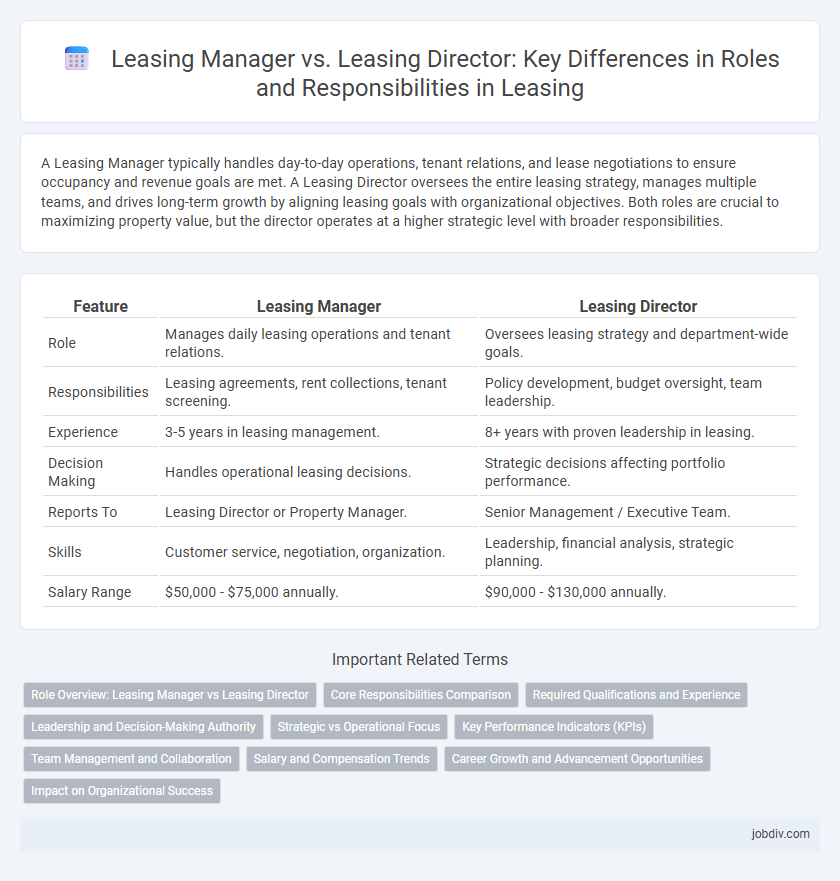A Leasing Manager typically handles day-to-day operations, tenant relations, and lease negotiations to ensure occupancy and revenue goals are met. A Leasing Director oversees the entire leasing strategy, manages multiple teams, and drives long-term growth by aligning leasing goals with organizational objectives. Both roles are crucial to maximizing property value, but the director operates at a higher strategic level with broader responsibilities.
Table of Comparison
| Feature | Leasing Manager | Leasing Director |
|---|---|---|
| Role | Manages daily leasing operations and tenant relations. | Oversees leasing strategy and department-wide goals. |
| Responsibilities | Leasing agreements, rent collections, tenant screening. | Policy development, budget oversight, team leadership. |
| Experience | 3-5 years in leasing management. | 8+ years with proven leadership in leasing. |
| Decision Making | Handles operational leasing decisions. | Strategic decisions affecting portfolio performance. |
| Reports To | Leasing Director or Property Manager. | Senior Management / Executive Team. |
| Skills | Customer service, negotiation, organization. | Leadership, financial analysis, strategic planning. |
| Salary Range | $50,000 - $75,000 annually. | $90,000 - $130,000 annually. |
Role Overview: Leasing Manager vs Leasing Director
A Leasing Manager oversees daily leasing operations, manages tenant relations, and coordinates lease agreements to ensure occupancy targets are met, focusing on execution and team supervision. A Leasing Director drives strategic leasing initiatives, develops long-term leasing plans, and leads regional or portfolio-wide leasing teams to maximize revenue growth and market positioning. Both roles are essential in property management but differ in scope, with the director emphasizing strategy and the manager concentrating on operational management.
Core Responsibilities Comparison
A Leasing Manager primarily oversees daily leasing operations, tenant relations, and lease agreement execution, ensuring occupancy targets are met efficiently. In contrast, a Leasing Director focuses on strategic planning, portfolio management, and leading leasing teams to optimize property revenue and market positioning. Both roles demand strong industry knowledge, but the Director emphasizes long-term growth and leadership, while the Manager concentrates on operational excellence.
Required Qualifications and Experience
A Leasing Manager typically requires a bachelor's degree in real estate, business administration, or a related field, coupled with 3 to 5 years of experience in property leasing or management. A Leasing Director usually demands a higher level of expertise with 7 to 10 years of progressive leadership experience in commercial or residential leasing, alongside advanced skills in strategic planning, contract negotiation, and team management. Both roles benefit from strong knowledge of market trends, legal compliance, and customer relationship management, but the Leasing Director must demonstrate proven success in driving revenue growth and managing large leasing portfolios.
Leadership and Decision-Making Authority
A Leasing Director holds higher leadership responsibilities, overseeing multiple property portfolios and setting strategic goals that impact the overall leasing operations. Leasing Managers focus on day-to-day team supervision and executing leasing plans within specific properties or regions. The Director's decision-making authority includes budget approval and long-term strategies, while Managers make operational decisions to achieve leasing targets.
Strategic vs Operational Focus
Leasing Directors prioritize strategic decision-making, overseeing long-term portfolio growth and market positioning to maximize asset value. Leasing Managers focus on operational execution, managing daily leasing activities, tenant relations, and contract negotiations to ensure consistent occupancy rates. This distinction highlights the Director's role in direction-setting contrasted with the Manager's hands-on implementation within property management.
Key Performance Indicators (KPIs)
Leasing Managers typically focus on KPIs such as occupancy rates, lease renewal percentages, tenant satisfaction scores, and rent collection efficiency to ensure day-to-day property leasing success. Leasing Directors are responsible for broader KPIs including overall portfolio growth, net operating income (NOI) improvements, strategic tenant mix optimization, and long-term lease agreement performance across multiple properties. Both roles emphasize metrics that drive revenue generation, tenant retention, and operational efficiency but differ in scope and strategic impact within leasing operations.
Team Management and Collaboration
Leasing Directors oversee multiple leasing teams, setting strategic goals and ensuring alignment across departments, while Leasing Managers focus on day-to-day team management and operational execution. Directors foster collaboration between leasing, marketing, and property management teams to enhance overall portfolio performance. Managers directly mentor leasing agents, coordinate team workflows, and implement leasing strategies to achieve occupancy and revenue targets.
Salary and Compensation Trends
Leasing Directors typically command higher salaries than Leasing Managers due to their broader strategic responsibilities and oversight of multiple property portfolios, with average annual compensation ranging from $90,000 to $150,000 compared to $60,000 to $100,000 for Leasing Managers. Compensation trends show Leasing Directors benefit more frequently from performance bonuses, stock options, and comprehensive benefits packages, reflecting their critical role in revenue growth and tenant retention strategies. Market data from real estate and property management sectors indicate that experienced Leasing Directors in major metropolitan areas earn premium salaries, often exceeding those in smaller markets where Leasing Managers dominate the operational roles.
Career Growth and Advancement Opportunities
Leasing Managers typically oversee daily leasing operations and tenant relations, serving as frontline leaders with hands-on responsibilities that build essential management skills. Leasing Directors hold higher strategic roles, directing multiple properties or regions, focusing on business growth, budgeting, and team leadership, which offers broader career advancement and executive-level visibility. Professionals progressing from Leasing Manager to Leasing Director benefit from enhanced decision-making authority and increased influence within real estate organizations.
Impact on Organizational Success
Leasing Managers directly oversee daily leasing operations and tenant relations, driving revenue through effective lease negotiations and property occupancy. Leasing Directors focus on strategic leadership, aligning leasing goals with organizational growth objectives and optimizing portfolio performance. The combined impact of these roles enhances tenant retention, maximizes income streams, and supports overall business success in property management.
Leasing Manager vs Leasing Director Infographic

 jobdiv.com
jobdiv.com